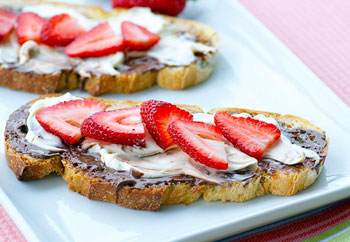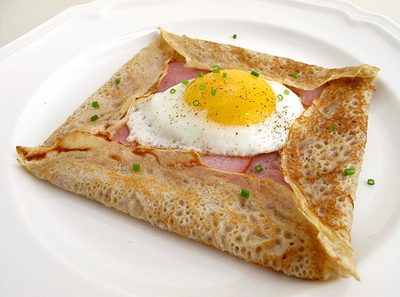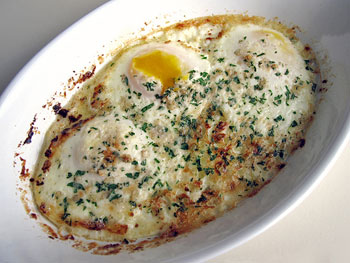 Mother's Day is this Sunday, which means you're either taking Mom out for brunch or making her brunch at home. Last year I provided a week's worth of recipes for Mother's Day brunch and had planned on doing the same this year. I have decided against it.
Mother's Day is this Sunday, which means you're either taking Mom out for brunch or making her brunch at home. Last year I provided a week's worth of recipes for Mother's Day brunch and had planned on doing the same this year. I have decided against it.
Instead, I'm going to provide you with one recipe, one sublimely simple yet decadent recipe, for Mascarpone, Nutella, and Fresh Berry Toasts. Crunchy Italian toast is slathered with creamy Nutella and rich mascarpone cheese then topped with sweet, sliced fresh strawberries.
When I posted on Facebook that I was creating Mother's Day brunch recipes and that one included Nutella and mascarpone, my dear friend Kate of Kate in the Kitchen, replied, "Well, what else do you need???" Exactly.
Mother's Day
Mothers Day
Mother's Day Gift Guide
Domaine Carneros Chocolate Truffles

Chocolate infused with Champagne - two great things that go great together.
Rare Wonders Talisman
from Lagos Fine Jewelry

Not sure which talisman to choose for your loved one? Take the quiz to find out! Or shop the collection.
From: Haley Schultheis of Nonsense & Sensibility
mini by Everpurse
A fashionable wallet clutch that’s also an iPhone charger? For the mom on the go, this will help her phone stay charged for 48 hours straight.
Oh yeah, we definitely want one of these.
Champagne Shine and Tan Leather Band

Let Mom Shine this Mother's Day with the ultimate in fashionable fitness.
{jb_left45}
Buckwheat Crepe with Ham and Eggs
 One of the most popular Parisian street foods are crêpes. You can buy them filled with just about any sweet filling, including fruit preserves and chocolate. But savory crêpes, also popular in France though much less known outside of the country, actually have a different name; they are called galettes. Thinner and larger than crêpes, they are made with buckwheat flour, a soft flour with an earthy flavor. The region of Brittany is very famous for its galettes, which can be filled with any number of savory fillings.
One of the most popular Parisian street foods are crêpes. You can buy them filled with just about any sweet filling, including fruit preserves and chocolate. But savory crêpes, also popular in France though much less known outside of the country, actually have a different name; they are called galettes. Thinner and larger than crêpes, they are made with buckwheat flour, a soft flour with an earthy flavor. The region of Brittany is very famous for its galettes, which can be filled with any number of savory fillings.
Eggs, thinly sliced meats, fish, cheese, and vegetable all make delicious fillings. My favorite, by far, is the combination of ham and eggs. Savory crêpes can be enjoyed for lunch or dinner, but they are especially nice for an elegant breakfast. With Mother's day this weekend, a breakfast of galettes would be a wonderful way to celebrate mom with some French flair. If you know how to make pancakes and fry eggs, making these breakfast bundles is not difficult at all.
Spinach and Ricotta Frittata Recipe
 Mother's Day is in one week. Are you prepared? Skip the flowers and the gift certificates, and make Mom a beautiful breakfast that she won't forget.
Mother's Day is in one week. Are you prepared? Skip the flowers and the gift certificates, and make Mom a beautiful breakfast that she won't forget.
I'm starting with an easy frittata inspired by my mom. Nutmeg has an affinity for spinach. I learned that from her.
OK, so she didn't say "affinity," but she loves them together.
So will you.
Spinach and Ricotta Frittata
Makes 8 servings
1 tablespoon unsalted butter
1 1/2 cups white mushrooms, thinly sliced
2 cups baby spinach, thinly sliced
8 large eggs
4 ounces (1/4 cup) whole milk ricotta cheese, drained
4 ounces (1/4 cup) grated Grana Padano cheese, divided
1/8 teaspoon ground nutmeg or fresh grated nutmeg
a liberal helping of salt and freshly ground black pepper
Melt butter in an 8-inch non-stick skillet over medium-low heat. Add mushrooms; saute 5 minutes, or until lightly browned. Add spinach and cook just until wilted. Season with salt and black pepper.
Baked Eggs
 What better way to celebrate moms and wives than by making them breakfast. This recipe for baked eggs has been my go-to breakfast recipe since I saw Ina Garten prepare it on her show, The Barefoot Contessa.
What better way to celebrate moms and wives than by making them breakfast. This recipe for baked eggs has been my go-to breakfast recipe since I saw Ina Garten prepare it on her show, The Barefoot Contessa.
It's perfect to serve for any meal, but it's especially nice for a Mother's Day breakfast. Serve it with bacon or sausage and some toast.
It's simple, fast, and very flavorful while also being elegant. The combination of toppings that I like to use include garlic, parsley, and Parmesan cheese, but any fresh herb can be added. Chives, oregano, thyme, and rosemary would all work well or use what's at hand.
I'm sure that whoever you make this recipe for will be very happy that you did.
More Articles ...
Welcome to the new One for the Table ...
Our Home Page will be different each time you arrive.
We're sure you'll find something to pique your interest...





